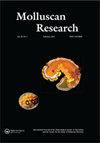Giants of Taiwan – comparative analysis of life history traits in four land snail species Changphaedusa horikawai, Formosana swinhoei, F. formosensis, and Formosana sp. (Stylommatophora: Clausiliidae: Phaedusinae)
IF 0.6
4区 生物学
Q3 ZOOLOGY
引用次数: 0
Abstract
ABSTRACT Family Clausiliidae (door-snails), which includes oviparous, embryo-retaining and viviparous species, can be a model group for studies on the evolution of reproductive modes in land snails. Yet, for understanding of evolutionary drivers leading to repeated changes of reproductive strategy, the identification of life history traits in phylogenetic lineages and geographical regions is fundamental. In this paper, we identified reproductive modes of clausiliid species endemic to Taiwan: Changphaedusa horikawai, Formosana formosensis, F. swinhoei, and an undescribed new species Formosana sp. Observations were conducted under laboratory conditions. Among Formosana species, oviparity predominated but embryo-retention was also recorded. The size of eggs and egg clutches differed between studied taxa. In contrast, C. horikawai was viviparous and delivered neonates. Anatomical examination of the fresh material allowed for unique observation of a large podocyst in embryos kept in the genital tract. This flattened structure may enable respiration or nutrient transfer between an embryo and a parent. In the regularly sampled wild population from Dawulun (N. Taiwan), gravid individuals were collected between April and November. The number of embryos reached three to nine per gravid individual. None of the species reproduced by self-fertilisation. Results of our study may support implementing conservation measures for malacofauna of Taiwan.台湾的巨人——四种陆生蜗牛——长脊螺、台湾海螺、台湾海螺和台湾海螺生活史特征的比较分析
摘要门蜗牛科包括卵生种、胚胎保留种和胎生种,是研究陆生蜗牛繁殖方式进化的模式类群。然而,为了理解导致繁殖策略反复变化的进化驱动因素,在系统发育谱系和地理区域中识别生命史特征是至关重要的。本文鉴定了台湾特有的幽闭科植物:长叶杜(Changpaedusa horikawai)、台湾福尔摩沙(Formosana formosensis)、swinhoei和一个未描述的新种台湾福尔摩萨(Formosanasp.)的繁殖模式。在台湾物种中,产卵占主导地位,但胚胎保留也有记录。所研究的分类群之间的卵和卵包的大小不同。相比之下,C.horikawai是胎生和分娩的新生儿。对新鲜材料进行解剖检查,可以独特地观察到保存在生殖道中的胚胎中有一个大的足囊肿。这种扁平的结构可以实现胚胎和亲本之间的呼吸或营养转移。在台湾大武伦野生种群的定期采样中,在4月至11月期间采集了怀孕个体。每个妊娠个体的胚胎数量达到三到九个。没有一个物种通过自我受精繁殖。我们的研究结果可能支持台湾软体动物保护措施的实施。
本文章由计算机程序翻译,如有差异,请以英文原文为准。
求助全文
约1分钟内获得全文
求助全文
来源期刊

Molluscan Research
生物-动物学
CiteScore
1.80
自引率
10.00%
发文量
27
审稿时长
>12 weeks
期刊介绍:
Molluscan Research is an international journal for the publication of authoritative papers and review articles on all aspects of molluscan research, including biology, systematics, morphology, physiology, ecology, conservation, biogeography, genetics, molecular biology and palaeontology.
While the scope of the journal is worldwide, there is emphasis on studies relating to Australasia and the Indo-west Pacific, including East and South East Asia. The journal’s scope includes revisionary papers, monographs, reviews, theoretical papers and briefer communications. Monographic studies of up to 73 printed pages may also be considered.
The journal has been published since 1957 (as the Journal of the Malacological Society of Australia until 1993). It is free to members of the Malacological Society of Australasia and the Society for the Study of Molluscan Diversity.
 求助内容:
求助内容: 应助结果提醒方式:
应助结果提醒方式:


